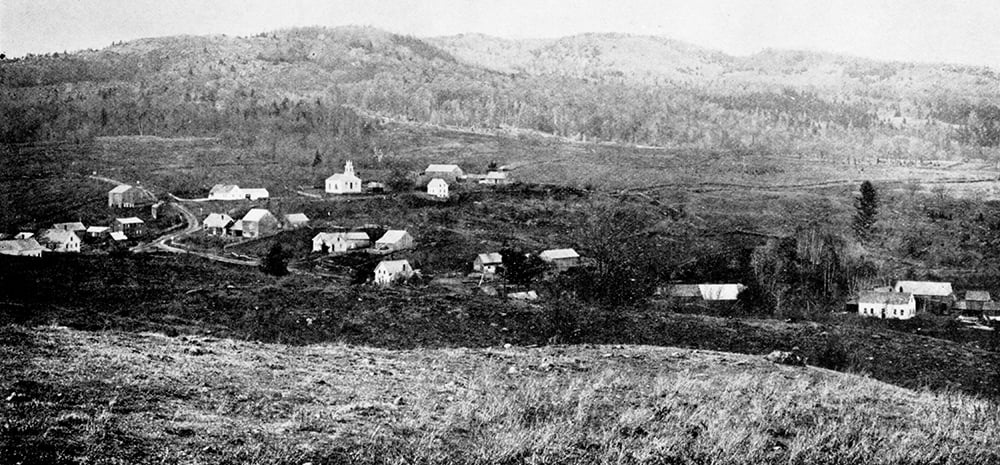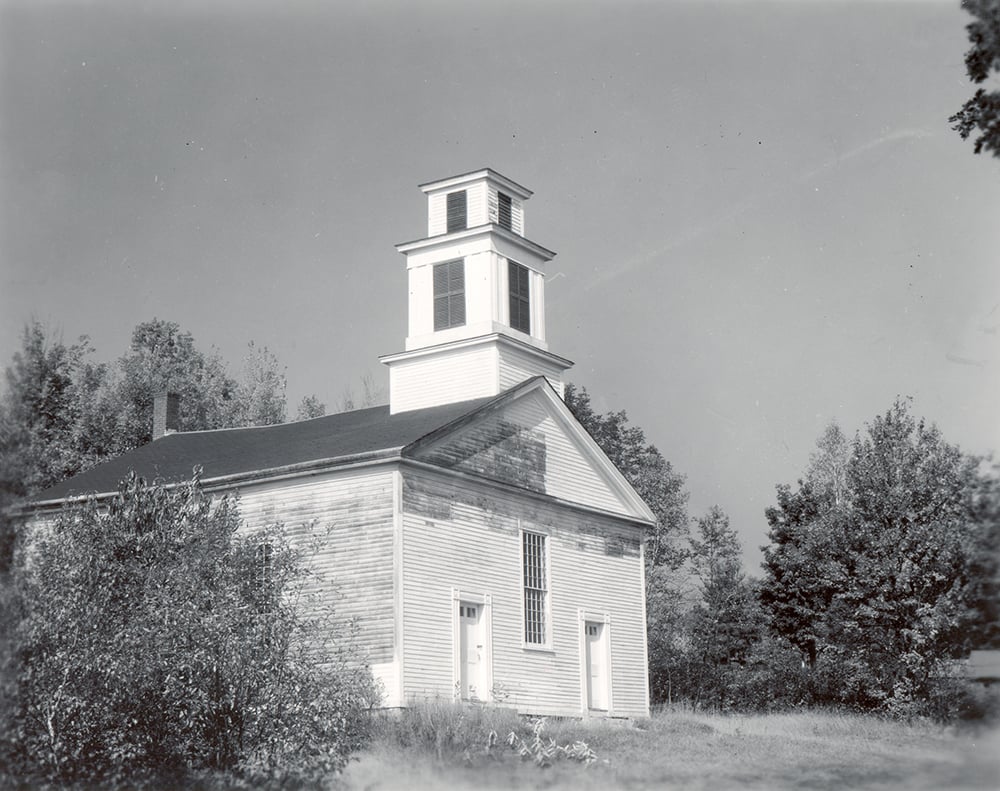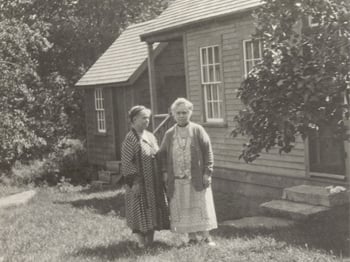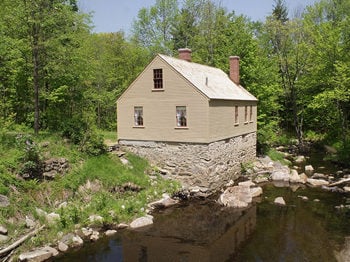These reminiscences of farm life in North Groton, New Hampshire, in the nineteenth century were written by George F. Cummings, a professor of Greek and Latin at Howard University, and were published in the January, 1929, issue of Old-Time New England, the bulletin of The Society For The Preservation of New England Antiquities, Inc. The article is reprinted by permission.
Mary Baker Eddy, then Mrs. Daniel Patterson, lived in North Groton between the years 1855 and 1860.
The author’s parents, Jothan and Mary Cummings, were married on January 1, 1833, and moved the same day to a North Groton farm where they lived for 60 years. Mr. Cummings now begins his narrative.

When they began to farm it, the only cleared land was five acres around the house and barn, where three or four tons of hay could be cut. Thick woods were on the east side of the road, where the grouse would drum by day, in their season. The only buildings were a one-story house and an open shed, and a good-sized barn. The house had only three rooms in it. It faced south and had a large chimney in the center. On the west side of the chimney was a large room occupying the west half of the house and having a large open fireplace where all the daily cooking and other needed things were done, and a brick oven, generally used on Saturday to bake beans, brown bread, pies, cakes, and so forth for Sunday and the following week. On the south side of the chimney was a smaller room with a small fireplace and a china cupboard. On the north side was a sleeping room. Upstairs, under the roof, was a place to fill with clutter. At first, mother had only this one room to do all her work in. In the fireplace was a long iron bar, called a crane, on which were several hooks from which pots and kettles could be suspended over the fire for boiling. Then mother had pans with long handles for frying over the coals. Potatoes were often roasted in the hot ashes, and meat was cooked by suspending it before the fire from a hook in the ceiling with a drip pan underneath. It was necessary to keep it turning so all sides would be well cooked. Spare rib of pork cooked in this way was delicious. Biscuits were cooked in tin ovens placed before a bright fire. The oven was made of shining metal so the heat could be reflected on all sides of the dough which rested on a tin plate in the center of the oven. Bread so cooked was very fine.
Friends wondered at father’s settling in such an uninviting place. By diligence and hard work he cleared more land , and increased his acreage of plowed land and stock. In November, 1833 , they were blessed with their first child — a girl, Emily Jane. It happened that on the night of November thirteen father was up later than usual, and on going out to the barn he chanced to look up and all the stars seemed to be let loose in the heavens and going in every direction. It was the November meteorite shower now so famous.
By the middle of the forties or a little before, father had begun to keep sheep, and mother would take the wool from the sheep’s back, wash, card in rolls, spin, and weave, and make into clothes. She usually colored the yarn with indigo so the cloth would be bluish, and with the white warp the cloth had a checkered look. Sometimes father would take the cloth to a mill in Campton where it could be dressed, as it was called. Then it was rather nice looking. Mother made nearly all my clothes out of such cloth till I was almost twenty-one.
Usually in October, as the evenings became longer, mother would begin to spill and, if it were a little chilly, she would have a fire in the old fireplace as the rolls would spin better when warm. It was a happy time for me when I could lie down in my trundle bed and hear the whir of the wheel and watch the shadows dancing on the ceilings and walls, and later still, in the long evenings, hear the beating of the loom as she wove the cloth for new clothes. In seasons of plenty we children would gather the various nuts — beechnuts and hazelnuts — and on the winter evenings invite the teacher and some friends for a social crack by the old fireplace with a big roaring fire. The flames would shoot half way up the chimney.
Sometimes father would kill a two-year old heifer in the fall. Then mother would try out the tallow and dip the candles, as it was called, making perhaps twenty or twenty-five dozen — enough to last us about all winter. In this way we could save the whale oil, then much used in lamps for night service. I must not forget to mention how they used to keep their fires before they had matches. In the evening they would burn some hard wood to coals, which keep better than soft wood, and cover them with ashes, and usually there would be live coals in the morning. Sometimes the coals would die out. Then we would get fire by flashing powder in the old flint gun-pan and catching the flame in dry shavings or tow. It is interesting to know that a newly-married couple would take live coals from the old house to start the fire in the new, if it was not too far to carry them.
Before stoves were used, sheet iron foot stoves were made to carry hard wood coals in order to keep feet and body warm in churches and other buildings in which there were no fireplaces. In those primitive days almost every community would have a store, where barter trade enabled the people to exchange their excess products for other necessary things as well as to buy some things outright. Besides these stores there were what were called individual pedlar carts drawn by one or two horses. These carts were loaded with hats, brooms, tin dishes, earthenware, and, in fact, as far as capacity allowed, everything a family might be in need of. These pedlars had each his own beat where he would go three or four times each season. In addition to these there were foot pedlars carrying two tin trunks of considerable size suspended from a shoulder yoke — one on each side. These trunks were filled with needles, pins, buttons, thread, ribbons, hooks-and-eyes and Yankee notions — little things often needed in the house. These men made their rounds at various times and some of them used to stop at father’s overnight.
When I was twelve or so years old there were some ten or more of the farmers in North Groton who used to raise hops. Hop picking came about the middle of September when there was a good moon in the evenings, and as most of the pickers were young people (boys and girls in their teens), they would gather in the evenings about some of the homes to roast corn and tell stones.
A little later came the corn huskings, when every week, for a while, there would be a round of them at different farmhouses. These huskings were always in the barns, all lighted with lanterns, and would generally last from about half-past six to nine, when all would go into the house, wash up, and sit down to tables loaded with baked beans, brown bread, coffee pumpkin pie, pies, cakes and so forth.
Later on, in November evenings, came the usual apple bees, in their rounds, occupying about the same hours as the huskings, but these gatherings were made up of the young people of the community. Usually four or five boys would bring their paring machines and pare the apples and other boys would quarter them. Then the girls would core the quarters and others, with a large needle and a string of twine a yard long, would string them — these strings later to be hung on a wood frame to be thoroughly dried and put away for use in the spring and summer. If the apples were to be used in making apple sauce, the quarters were not put on a string, but left in tubs to be made into sauce later.
These festivities would last till into November, when the young people would start what were called “Kissing Parties” or “Social Gatherings” with their various stunts and sports. Our winter District School began the Monday after Thanksgiving, to continue usually for twelve weeks. There was occasionally an evening party, but our sports were mostly sliding on sleds down the hills near the school and skating on the pond close by, when there was good ice, and making snow forts. Generally on New Year’s day evening the older boys and girls formed a party and had a merry sleigh ride to Hebron to visit Reverend Mr. Conant who preached one-half of the time in each town — that is, every other Sabbath in each place. It was called “a Donation Party.” In addition to these times we had singing schools two evenings a week till about the middle or last of February, when often the snows were so deep as to make bad roads — our schools, also, closed about this time. For two or three weeks it was not very lively, but annual town and State election came near the middle of March and for years this gave an exciting day for men and boys.
There was quite a rivalry between our school and the South Groton or Intervale School in spelling. In these years there were two so-called “Spelling Matches” each winter, one in each district, always in the evening, thus giving a good sleigh ride for each school with a jolly time.
Soon after the March Election came the sugaring season. When the snow began to melt by day and freeze by night, then was the season to tap the maple trees and boil down the sap into syrup and “sugar off,” when we could have the sugar or molasses on snow. In those days most of the sap was boiled in the open, with an extemporized fireplace, without any shelter. It was possible for me, standing in our dooryard or house, to see three or four sugar places and sometimes, even, to catch a sight of the one in charge as he came in front of the fire.
The thawing by day would generally give a crust in the evening, so when there was a good moon and crust many of us boys and girls would have a run to some camp for a sugaring-off.
When the sugaring was ended the days were long and the nights short, and our festivities would be converted into hours of toil.
The only thing to look forward to was the Fourth of July. In the years before the Civil War this day was generally observed by having a celebration of some kind either in Groton or one of the surrounding towns. The first one I can remember was held near the Town House in Groton, in Uncle Blood’s pasture. As one goes from his house toward Hebron, he goes down a little hill to a level place on the left, flanked by quite a rocky ridge. There were no trees on this spot, but the committee on celebration cut a lot of smallish trees and stuck them in the ground to make a kind of grove for the tables and speaker’s stand. There were held the exercises. On the ridge was placed the old brass cannon for the purpose of firing a salute. The cannon belonged to the Artillery Company then existing in Groton, and was kept in a gun house back of the present Town House. It was moved away at the time of the Civil War.
I remember another celebration. This one was in the early fifties and was at Hebron. A good company of boys and girls formed a party and were taken down there in a hay-rack and four horses.
In the evening there were some fireworks, which I saw for the first time in my life.
I will speak of only one other celebration which was held in South Groton in Abel Crosby’s sugar orchard. I was then twenty-four years old and came home from Meriden to play in our North Groton Band, which furnished the music for the day. This was in the summer of ’64, during the Civil War, and my first year fitting for college. The occasion gave me a chance to visit the lady of my choice, which, of course, to me, was the best part of the celebration.
Perhaps I ought to mention other events that were looked forward to always with much pleasure. One was the season of grain threshing, occurring in October and the first part of November, when wheat, oats, barley, etc., were beaten off the straw. In the earlier days this was done by the use of hand flails in the winter when men had not much to do. Later, in my early days, came the threshing machine to do the work. It was rather a cumbersome thing to move about, but it could be easily taken from place to place on four wheels drawn by horses. These same horses were also trained to tread on an inclined, endless plank-walk that generated the power that turned a large wheel connected by a belt with a small wheel on an arbor of a cylinder set with teeth that were adjusted to other teeth in the frame so that the bundles of grain, properly fed in by a man, would be separated from the straw and the straw would be thrown out and the grain would be dropped into a holder ready to be put into a bag or bin. Some years it would take two days to do our threshing. The owner usually arranged for localities so as to avoid travel back and forth. Children always enjoyed the hum and noise of the machinery and the hissing of the straw as it left the thresher.

When I was some eight or ten years old, there lived in town men known as cobblers or makers of boots and shoes. This was before such things could be bought at stores, and, of course, there was very little leather to be had, so the farmers used to kill calves and cattle to eat and send the skins to nearby tanneries to be made into different kinds of leather as calfskin, cowhide, sole leather, or thick leather used for the bottoms of shoes and boots. Our nearest tannery was in Hebron, known as Berry’s tannery. Of course there were some farmers who sold the skins to the tanners, and these in turn would sell to the cobblers in the various towns. There was one cobbler in our town who used to go about, according to previous engagement, to make up boots. and shoes for the winter for a family. His name was Seth Blanchard. Father always employed him for a week or so to shoe up the family, usually in November.
After my ninth year work seemed to be the order of the day. Some of my playmates had chances to go off for a good time but such things were not for me and I see now, and really knew then, it was not all work and no enjoyment for me, for in early spring, as I would go to bed, with windows all open, the noise of the brook and, later in the spring, the croaking of the frogs and the whip-poor-will call gave sweet lullabies. Then, by day, there was a little while for fishing or a chance to gun, or some afternoon to go to a military training to see the dress parade and hear the music or go to a brigade muster in the early fall and see the colorful maneuvers — all these, with the attendant shows, did break up the humdrum of life and gave me something to talk about afterwards.
Some years the beechnuts would be abundant and late in the fall, after the hard frosts had opened the shucks so the nuts could drop out, we children were allowed to spend the day in the woods gathering them for “a jolly,” on some winter evening, together with other nuts of fall collection. Nor should we forget to speak of chances to get a store of spruce gum to chew — sometimes to carry in our pockets to chew in school and so annoy our teacher.
One of my pleasant memories of childhood was being tucked under the buffalo robe in the sleigh when my parents would drive off to spend an evening with some friends. Gossip, bear stories, and tales of early days went the rounds amid the crunching of apples and the sipping of the sparkling cider.
After all, children did have many good times in those days of toil of long ago. Although the work seemed almost drudgery, yet it did lend zest to the times of recreation and often led to strength of body well fitted to endure later burdens.
Later in my teens I had the joy of training every year a team of yearling steers and getting them used to going and working when yoked together. I had a small yoke made for the purpose (now in my chamber in Groton) and after they were well used to going together under the yoke I attached them to the tongue of a good-sized sled and drove on the crust of the snow in the early spring, over the fields or into the sap place to gather the sap or perhaps go to some neighbor on an errand. I always delighted to train the steers in this way. One of our neighbor’s boys at one time had a similar pair and sometimes we would hitch them together for a run.
When I was fifteen or sixteen I wanted to go down to the village in the evening to play with the boys of my age, but my father did not like to have me go often, and so he bought me a seraphine, the one now at my home at Groton, and my cousin Permelia Cheney gave me some instructions and from an instruction book I learned in the evenings to play church music instead of being with the boys. By taking one course of lessons I have been able to play organs in churches where I have been, besides playing the one in our church in North Groton for several years before I left home. The ability to play common music has enabled me to be helpful wherever I have been and has given me much real pleasure.
Before the time of the railroads, there were, in different sections of northern New England, men called drovers, whose main business seemed to be to buy up livestock, sheep and cattle, and drive them to Brighton (Mass.) market to be slaughtered for the various meat markets near Boston. One of these drovers, Gill Fletcher, lived at North Groton. As father’s place was very central, he used to collect his droves in our yard. It was a sight to look upon the yard filled with cattle of all colors, red, white, black, yellow, brown, grizzly, speckled, striped; big horns, little horns, no horns, lop horns, and so forth. Usually there would be two or three in the herd or perhaps more, that would lock horns for the mastery. The great time came when they were let out of the yard and headed for Brighton.
About this same time the Boston, Concord & Montreal Railroad was being built through Wentworth and Rumney. I do not remember the year, but probably it was about 1854 when I had my first ride in the cars. It was a Fourth of July excursion to the Weirs and from there to Wolfboro, across Winnepesaukee on a boat called the Lady of the Lake.
My boyhood days come back to me afresh with all their lights and shades.

